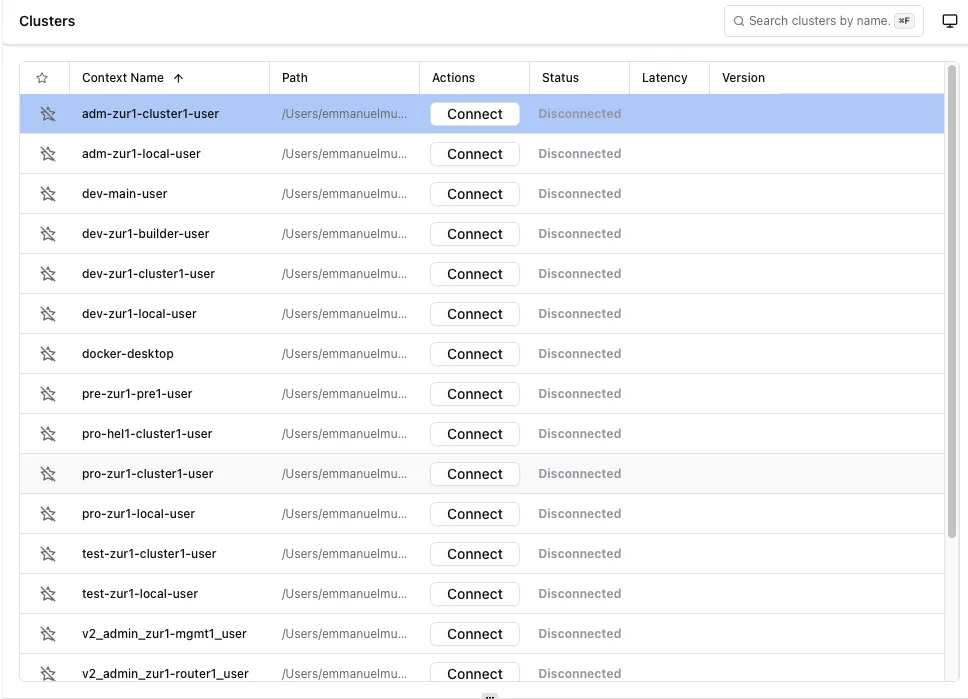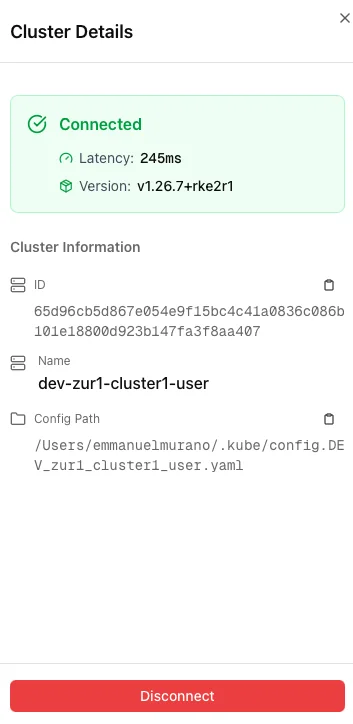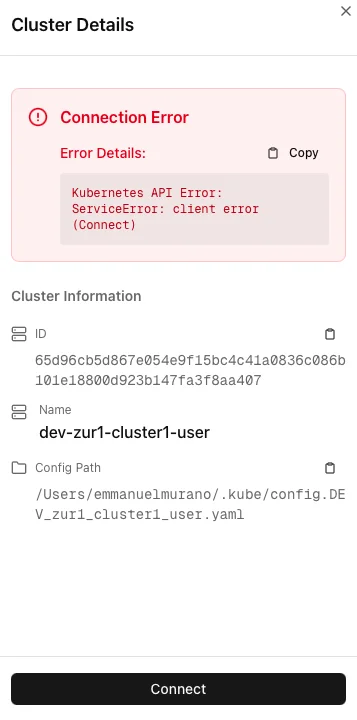Clusters
The Clusters page is your central hub for managing all Kubernetes cluster connections. View, connect, and manage multiple clusters from a single interface.
What You'll Find
The Clusters page displays all available Kubernetes contexts from your kubeconfig files in a searchable table.

Table Columns
- Favorite - Star icon to mark frequently-used clusters for quick access
- Context Name - The name of your Kubernetes context (e.g.,
dev-zurl-cluster1-user) - Path - Location of the kubeconfig file
- Actions - Connect or disconnect button
- Status - Current connection state (Disconnected, Connecting, Connected)
- Latency - Response time in milliseconds (shown when connected)
- Version - Kubernetes server version (shown when connected)
Connecting to a Cluster
- Find the cluster you want to connect to in the table
- Click the Connect button in the Actions column
- The status will change to Connecting (orange indicator)
- Once connected, the status shows Connected (green indicator) with latency and version information

Once connected, you can explore the cluster's resources, namespaces, and workloads.
Cluster Details
Click on a cluster's name or row to open the details sidebar showing:
- Connection Status - Current state with color-coded indicator (green for Connected)
- Latency - Response time in milliseconds (e.g., 245ms)
- Kubernetes Version - Server version (e.g., v1.26.7+rke2r1)
- Cluster ID - Unique cluster identifier with copy button
- Name - Context name (e.g.,
dev-zurl-cluster1-user) - Config Path - Full path to the kubeconfig file with copy button
When connected, you'll see a Disconnect button at the bottom of the sidebar.

Status Indicators
Clusters can be in different states, each with its own visual indicator:
- Disconnected (Gray text) - Not currently connected
- Connecting (Orange text) - Connection in progress
- Connected (Green text with latency/version) - Actively connected and ready to use
- Error (Red text) - Connection failed or cluster unavailable
When a cluster is connected, the table row shows additional information including response latency and Kubernetes version.
Connection States
Connecting:

Connected:

Error:

Disconnecting from a Cluster
You can disconnect from a cluster in two ways:
From the table:
- Find the connected cluster (shows green "Connected" status)
- Click the Disconnect button in the Actions column
- The status will change to Disconnected
From the details sidebar:
- Open the cluster details by clicking on its name
- Click the Disconnect button at the bottom of the sidebar
You can reconnect at any time by clicking Connect again.
Searching Clusters
Use the search box at the top right (⌘F shortcut) to quickly find clusters by context name or path.
Favorite Clusters
Click the star icon next to any cluster to mark it as a favorite. This helps you quickly identify your most frequently-used clusters.
Troubleshooting
Connection Errors
When a cluster shows an Error status, click on the cluster name to open the details sidebar and view the error details:

The sidebar will display:
- Connection Error indicator (red)
- Error Details with copy button - Shows the specific error message (e.g., "Kubernetes API Error: ServiceError: Client error (Connect)")
Common solutions:
- Verify the kubeconfig file exists and is valid
- Check that the API server is accessible
- Ensure you have network connectivity to the cluster
- Verify your kubeconfig credentials are valid
- Check if the cluster requires VPN or specific network access